 By Staff
By Staff
April 17th, 2020
BURLINGTON, ON
The Regional Public Health Unit releases updates on COVID-19 crisis up to and including Wednesday end of day on April 15, 2020:
Cases over time
34 COVID-19 cases reported to Halton Region Public Health since the last update (24 confirmed + 10 probable)
393 COVID-19 cases reported to Halton Region Public Health to date (350 confirmed + 43 probable)
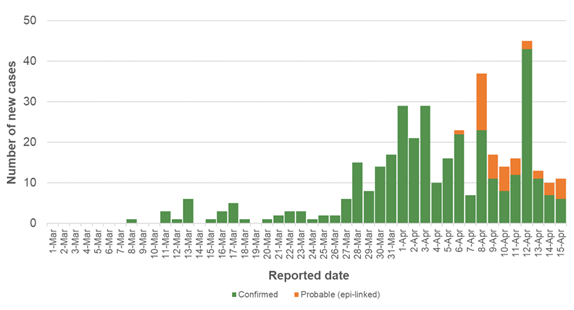
COVID-19 cases, by reported date, Halton Region, Mar. 1-Apr. 15, 2020
Figure shows the 393 COVID-19 cases that had been reported to Halton Region Public Health by end of the day on April 15. All cases have been graphed according to the date they were reported, which is often several days after the onset of symptoms. Among the cases in this figure, 34 were reported since the last update (meaning they were reported between April 13 and April 15, 2020).
Individuals who are lab-confirmed cases are shown in green. Individuals who are probable cases are shown in orange. Probable cases are epi-linked cases, which means they are presumed to have COVID-19 because they are symptomatic close contacts of cases or returning travelers who have COVID-19 symptoms.
Case demographics
67 cases live in an institution (17% of all cases)
55 cases work in health care (14% of all cases)
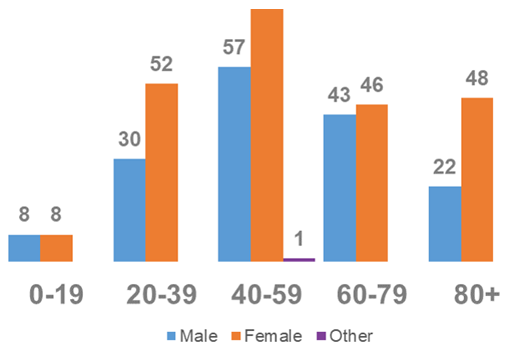
COVID-19 cases, by age and sex, Halton Region, 2020
Figure shows that by end of the day on April 15, the most COVID-19 cases were among Halton residents aged 40-59 (with 136 cases, or 35%). 232 of the 393 cases (59%) were female.
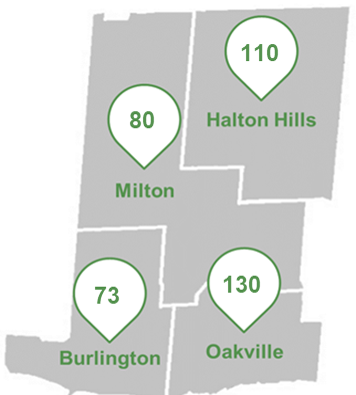
COVID-19 cases, by municipality of residence, Halton Region, 2020
Figure shows that by end of the day on April 15, the greatest number of COVID-19 cases were among residents of Oakville (with 131 cases, or 33%). Please note this figure shows counts, and therefore does not take into account the different population sizes or age structures of the four municipalities. Counts in municipalities can also be inflated by outbreaks that have occurred within institutions in their boundaries.
Case exposure source
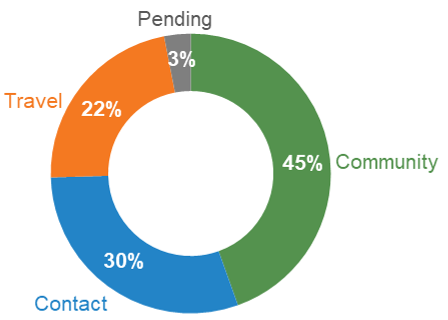
Percentage of COVID-19 cases, by exposure source, Halton Region, 2020
Figure shows that by end of the day on April 15, 175 of Halton Region’s COVID-19 cases (45%) had no known travel or contact history, and therefore were believed to have acquired the virus within Ontario, making them community cases. 118 cases (30%) had contact with a confirmed case that was believed to be the source of their infection. 88 cases (22%) had a history of travel that was believed to have been the source of their infection. Information on exposure source was pending for the remaining 12 cases (3%).
Case outcomes
52 cases who have ever been hospitalized to date (27 listed as currently in hospital)
146 cases who have recovered to date
12 cases who have died to date (7 of the deceased were institutional residents)
Institutional outbreaks
0 confirmed institutional outbreaks of COVID-19 reported to Halton Region Public Health since the last update
7 confirmed institutional outbreaks of COVID-19 reported to Halton Region Public Health to date
Among the seven confirmed institutional outbreaks reported to date, four (57%) have been in retirement homes, while two occurred in long-term care homes and one occurred in a hospital. None of the confirmed outbreaks were reported since the last update. None of the confirmed outbreaks have yet been declared over. Please note these counts do not include any suspected outbreaks that remain under investigation.
Lab testing
6,000 Halton residents are known to have been tested for COVID-19 to date
Comparison to Ontario
8,961 total confirmed COVID-19 cases reported in Ontario to date
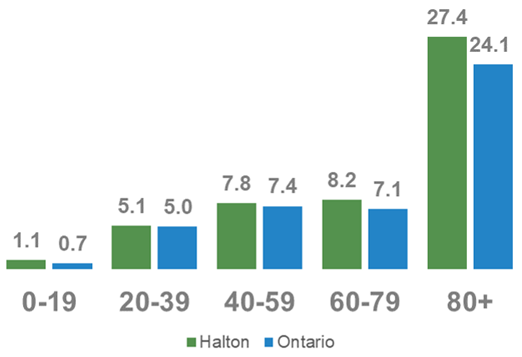
Age-specific rates of COVID-19 (per 10,000 population), Halton Region and Ontario, 2020
Figure 5 shows age-specific rates of COVID-19 for Halton and Ontario. Rates take into account the population size of each age group to make it possible to compare between different areas. Halton’s age-specific rates are similar to the provincial rates for all age groups (for example, while Halton has 27.4 cases per 10,000 residents aged 80+, this is not statistically significantly different from the 24.1 cases per 10,000 residents aged 80+ in Ontario). It is important to note that these rates will fluctuate as numbers increase throughout the pandemic, and that differences between age groups may reflect differences in the likelihood of developing symptoms and being tested.
Data limitations and data sources
Halton case data: integrated Public Health Information System (iPHIS), extracted at 7:00 AM on April 16, 2020, to reflect data entered by the end of the day on April 15, 2020
Halton lab data: COVID Data Information System, extracted on April 16, 2020.
Ontario case data: Public Health Ontario, Epidemiologic Summary, COVID-19 in Ontario: January 15, 2020 to April 15, 2020, posted on April 16, 2020 to https://www.ontario.ca/page/2019-novel-coronavirus
Denominators for Halton and Ontario age-specific rates: Population projections [2020], IntelliHEALTH Ontario, extracted on April 8, 2020.
Data notes
All cases of diseases of public health significance diagnosed in Ontario are entered into iPHIS by local public health units. iPHIS is the Integrated Public Health Information System. It is a dynamic disease reporting system which allows ongoing updates to data previously entered. As a result, data extracted from iPHIS represent a snapshot at the time of extraction and may differ from previous or subsequent reports as data are updated.
The data only represent cases reported to public health and recorded in iPHIS. As a result, all counts will be subject to varying degrees of underreporting due to a variety of factors, such as disease awareness and medical care seeking behaviours, which may depend on severity of illness, clinical practice, changes in laboratory testing, and reporting behaviours.
Cases are included if their “diagnosing health unit” in iPHIS is Halton Region, which means counts include only individuals whose primary residence is in Halton Region. The case may not necessarily have been managed by Halton Region, if they were temporarily residing elsewhere during their case management period. Cases managed by Halton Region who normally live elsewhere but who were managed by Halton Region staff because they were temporarily residing in Halton during their case management period have not been included.
Cases for which the Disposition Status in iPHIS was reported as ENTERED IN ERROR, DOES NOT MEET DEFINITION, DUPLICATE-DO NOT USE, or any variation on these values have been excluded.
Figure 1 distinguishes between lab-confirmed and probable cases. Since April 7, probable cases are defined as epi-linked cases, meaning they are symptomatic close contacts of cases or returning travelers who have COVID-19 symptoms and therefore are presumed to have COVID-19. All other figures and numbers include both confirmed and probable cases combined.
In subsequent reports, counts in Figure 1 may increase as cases are added from past dates due to delayed data entry or new arrival of lab results. To minimize such retrospective changes, cases have been graphed according to case reported date, which does not reflect onset of illness.
Cases are considered to live in an institution if the name of a facility (e.g. a long-term care home, retirement home, prison) has been entered for their address in iPHIS.
Cases are considered to work in health care if they are known to have an occupation that involves caring for patients, e.g. physician, nurse, occupational therapist, recreational therapist, chiropractor, paramedic, midwife, orderly, etc.
Exposure type is determined by examining the exposure and risk factor fields from iPHIS to determine whether a case travelled, was a contact of a case or neither. A hierarchy has been applied as follows: Travel-related > Close contact of a confirmed case > Neither (indicating community acquisition) > Information pending.
Case outcomes (hospitalizations, recovery, deaths) reflect the latest available information reported to Halton Region Public Health and recorded in iPHIS by the extraction time.
Institutional outbreaks include outbreaks of COVID-19 in settings such as long-term care homes, retirement homes, hospitals, and prisons.
Lab testing data reflects only lab tests that have been reported to Halton Region Public Health and entered into CDIS. There may be more residents who have been tested but not reported to Public Health.
Related Regional Health reports



















My question is how many residents in Burlington have been tested for Covid 19? Until a lot more testing is happening the statistics in my opinion are of little value.
Why is Ontario doing so little testing? The logical answer is that we do not have the necessary resources to test.
I sound like a broken record, but all residents should wear a fabric mask when in public. If everyone wore a fabric mask we would be protecting each other.
Why are they covering up the names of the institutions?
Excellent question !! According to Halton Region they “cannot speak to the details.”
This utter lack of transparency is unacceptable and it the opposite of what we are seeing elsewhere. We should all be contacting Gary Carr. What is going on here in Halton?
The numbers are also extremely unreliable thanks to the lack of testing and even reporting of so many cases.